<< Previous | Displaying results 5901-5950 of 6769 for "" | Next >>
Execution site in the Flossenbürg concentration camp, seen here after liberation of the camp by US armed forces. Flossenbürg, Germany, after May 1945.
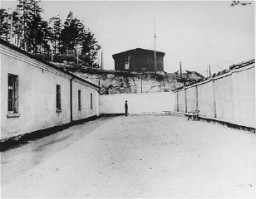
After the liberation of the Flossenbürg camp, a US Army officer (right) examines a crematorium oven in which Flossenbürg camp victims were cremated. Flossenbürg, Germany, April 30, 1945.

Entrance gate to the Riga ghetto. This photograph was taken from outside the ghetto fence. Riga, Latvia, 1941-1943.
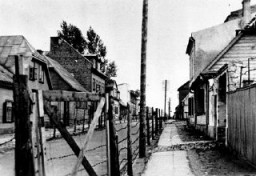
Entrance to the Riga ghetto. Riga, Latvia, 1941–43. During the Holocaust, the creation of ghettos was a key step in the Nazi process of separating, persecuting, and ultimately destroying Europe's Jews.
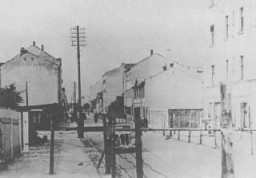
Jewish families with bundles of belongings during deportation from the Kovno ghetto in Lithuania to Riga in neighboring Latvia. Kovno, Lithuania, 1942.
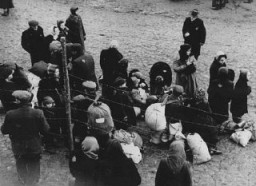
14-year-old Sara Bialovadska, imprisoned in the Kaiserwald concentration camp near Riga. Latvia, 1943.

Lithuanian militiamen in Kovno round up Jewish women. Kovno, Lithuania, June-July, 1941.
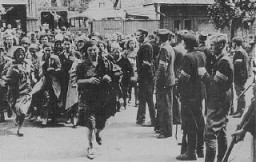
Crowd views the aftermath of a massacre at Lietukis Garage, where pro-German Lithuanian nationalists killed more than 50 Jewish men. The victims were beaten, hosed, and then murdered with iron bars. Kovno, Lithuania, June 27, 1941.
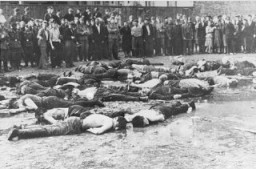
This photograph shows the Rudnicki Street entrance to the Vilna ghetto. The signs on the fence claim there is danger of contagion and prohibit the bringing of food or wood into the ghetto. Photograph taken in 1941–42.
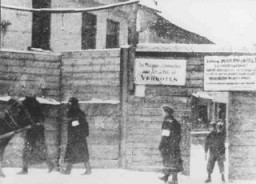
Lithuanian collaborators guard Jews before their execution. Ponary, Lithuania, June–July, 1941.
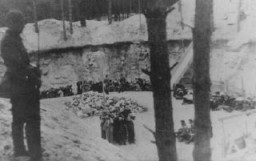
Jews at the railroad station before deportation. Puchov, Czechoslovakia, March 1942. (Source record ID: E39 Nr.2447/8)
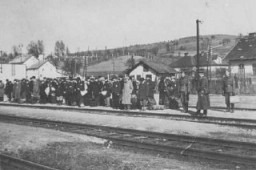
Scene during the deportation of Macedonian Jews by Bulgarian occupation authorities. Skopje, Yugoslavia, March 1943.
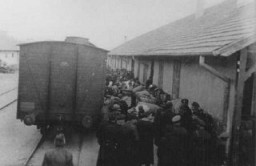
A building in Rome, Italy, used as Gestapo (secret state police) headquarters during the German occupation. This photograph was taken after US forces liberated the city. Rome, Italy, June 1944.
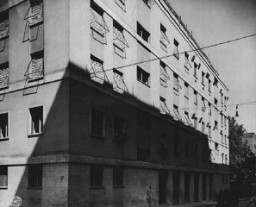
Class photograph of students at the San Leone Magno Fratelli Maristi boarding school in Rome. Pictured in the top row at the far right is Zigmund Krauthamer, a Jewish child who was being hidden at the school. Rome, Italy, 1943–44.
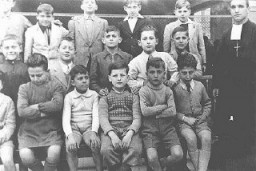
A cheering crowd greets Adolf Hitler as he enters Vienna. Austria, March 1938. After a prolonged period of economic stagnation, political dictatorship, and intense Nazi propaganda inside Austria, German troops entered the country on March 12, 1938. They received the enthusiastic support of most of the population. Austria was incorporated into Germany the next day.
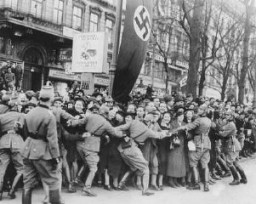
A Jewish man deported from Vienna, Austria, performs forced labor in the Opole Lubelskie ghetto. Poland, date uncertain.

View of the Gusen camp, which became a subcamp of the Mauthausen concentration camp. This photograph was taken after the liberation of the camp. Gusen, Austria, May 1945.
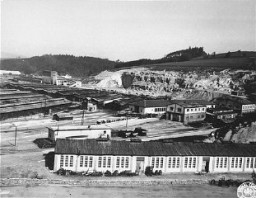
Corpses found by US soldiers after the liberation of the Gunskirchen camp, a subcamp of the Mauthausen concentration camp. Austria, after May 5, 1945.
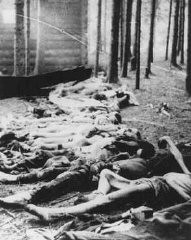
Survivors of the Ebensee subcamp of the Mauthausen concentration camp. Ebensee, Austria, May 8, 1945.
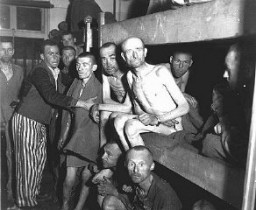
Site where members of Einsatzgruppe A and Estonian collaborators carried out a mass execution of Jews in September 1941. Kalevi-Liiva, Estonia, after September 1944.
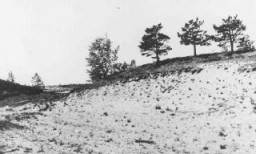
Deportation from the Kovno ghetto to forced-labor camps in Estonia. Kovno, Lithuania, October 1943.
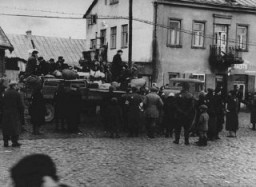
Corpses of inmates from the Klooga camp stacked for burning. Soviet troops discovered the bodies when they liberated the camp. Estonia, September 1944.
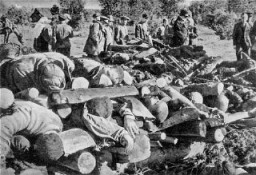
Corpses of inmates from the Klooga camp stacked for burning. Soviet troops discovered the bodies when they liberated the camp. Estonia, September 1944.
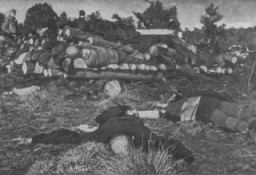
Corpses of inmates discovered by Soviet troops at the Klooga forced-labor camp. Nazi guards and Estonian collaborators had executed the prisoners and then stacked the bodies for burning. Estonia, September 1944.

At the Klooga concentration camp, Soviet soldiers examine the bodies of victims left by the retreating Germans. Klooga, Estonia, September 1944.
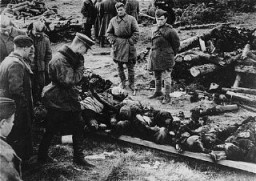
View of the Jasenovac concentration camp in Croatia. Jasenovac, Yugoslavia, 1941-1942.
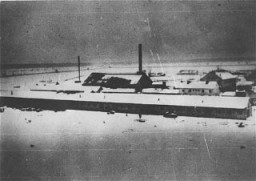
Ustasa (Croatian fascist) guard next to a watchtower at the Jasenovac concentration camp. Yugoslavia, between 1941 and 1944.
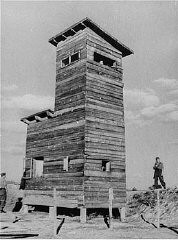
View of the brick factory in the Jasenovac concentration camp in Croatia. Jasenovac, Yugoslavia, between 1941 and 1944.

Ustasa (Croatian fascist) camp guards order a Jewish man to remove his ring before being shot. Jasenovac concentration camp, Yugoslavia, between 1941 and 1945.
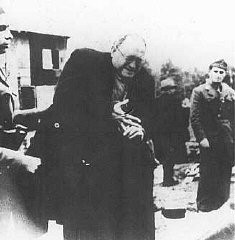
Ustasa (Croatian fascist) guards alongside belongings of prisoners at the Jasenovac concentration camp. Yugoslavia, between 1941 and 1945.
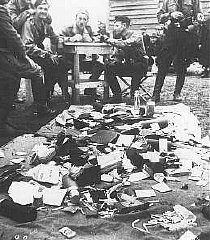
Ustasa (Croatian fascist) guards search prisoners and take their belongings upon arrival at Jasenovac concentration camp. Yugoslavia, between 1941 and 1945.
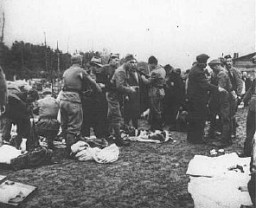
Ustasa (Croatian fascist) guards force a prisoner into a pit to be shot. Jasenovac concentration camp. Yugoslavia, probably 1942.
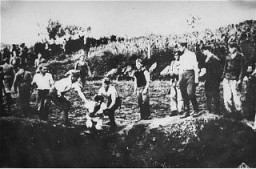
A Ustasa (Croatian fascist) guard stands amid corpses at the Jasenovac concentration camp, Yugoslavia, 1942.
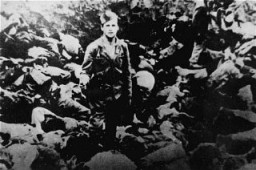
Serbs and Roma (Gypsies) who have been rounded up for deportation are marched to the Jasenovac concentration camp under Ustasa guard. Yugoslavia, 1942–43.
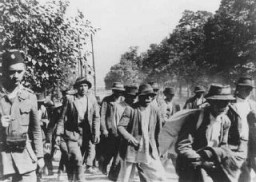
Serbs interned in the Jasenovac concentration camp in Croatia. Jasenovac, Yugoslavia, 1941–45.
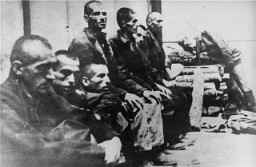
This document is a referral slip that ordered the individual names, Samuel Hirschenhauser, to the Jasenovac camp in Croatia. June 24, 1942.
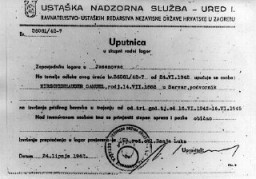
Members of the SA post signs demanding that Germans boycott Jewish-owned businesses. Berlin, Germany, April 1, 1933.
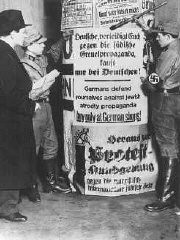
A boycott sign posted on the display window of a Jewish-owned business reads: "Germans defend yourselves against Jewish atrocity propaganda. Buy only at German shops!" Berlin, Germany, April 1, 1933.
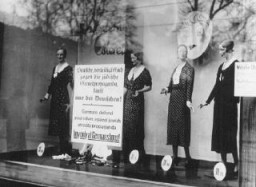
At Berlin's Opernplatz, the burning of books and other printed materials considered "un-German" by members of the SA and students from universities and colleges in Berlin. Germany, May 10, 1933.

Entrance to the public baths in Wannsee with a sign stating, "Entrance to Jews is forbidden." Berlin, Germany, 1935.
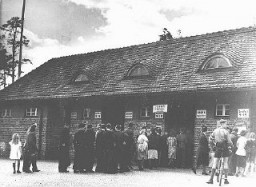
German Jews seeking to emigrate wait in the office of the Hilfsverein der Deutschen Juden (Relief Organization of German Jews). On the wall is a map of South America and a sign about emigration to Palestine. Berlin, Germany, 1935.

German Jews crowd the Palestine Emigration Office in an attempt to leave Germany. Berlin, Germany, 1935.
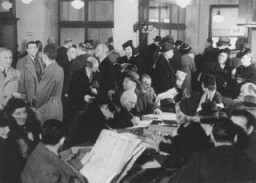
Windows of a Jewish-owned store painted with the word Jude (Jew). Berlin, Germany, June 19, 1938.

View of the Prinzregenten Street synagogue. It was destroyed by fire during the Kristallnacht ("Night of Broken Glass") pogrom. Berlin, Germany, November 9-10, 1938.
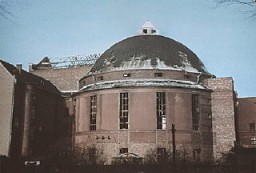
German Jews trying to emigrate to Palestine form long lines in front of the Palestine and Orient Travel Agency. Berlin, Germany, January 22, 1939.
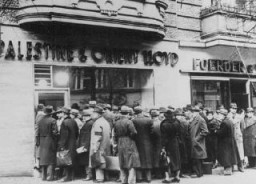
Headquarters of the SS chief at 9 Prince Albert Street. Berlin, Germany, date uncertain.
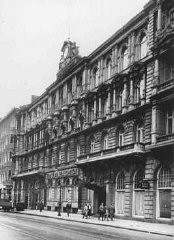
Headquarters of the Nazi Gestapo (secret state police) and of the Reich Security Main Office (RSHA). Berlin, Germany, date uncertain.
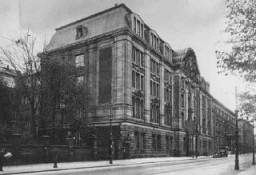
Jewish forced laborers at Tempelhof in Berlin. Three of the four pictured standing were later deported. Berlin, Germany, 1940.
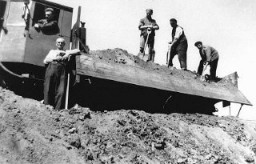
Members of a Jewish family walking along a Berlin street wear the compulsory Star of David badge. Berlin, Germany, September 27, 1941.
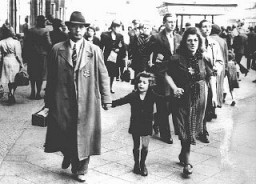
Joseph Levi, a pharmacist and the head of the Jewish community of Komotine, wearing the compulsory Jewish badge. Bulgarian occupation authorities later deported him to the Treblinka killing center. Komotine, Greece, 1942.
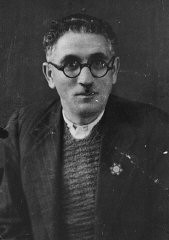
We would like to thank Crown Family Philanthropies, Abe and Ida Cooper Foundation, the Claims Conference, EVZ, and BMF for supporting the ongoing work to create content and resources for the Holocaust Encyclopedia. View the list of donor acknowledgement.